Chalcis
Chalcis (/ˈkælsɪs/;[3] Ancient Greek & Katharevousa: Χαλκίς, Chalkís) or Chalkida (Modern Greek: Χαλκίδα, romanized: Halkídha, [xalˈciða]) is the chief town of the island of Euboea in Greece, situated on the Euripus Strait at its narrowest point. The name is preserved from antiquity and is derived from the Greek χαλκός (copper, bronze), though there is no trace of any mines in the area.[4] In the late Middle Ages, it was known as Negropont(e), an Italian name that has also been applied to the entire island of Euboea.
Chalcida Χαλκίδα | |
|---|---|
 Chalcis' seafront | |
 Flag | |
 Chalcida Location within the region 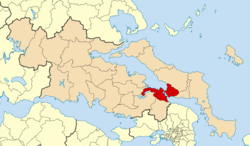 | |
| Coordinates: 38°27′45″N 23°35′42″E | |
| Country | Greece |
| Administrative region | Central Greece |
| Regional unit | Euboea |
| Government | |
| • Mayor | Eleni Vaka (New Democracy) |
| Area | |
| • Municipality | 424.77 km2 (164.00 sq mi) |
| • Municipal unit | 30.80 km2 (11.89 sq mi) |
| Highest elevation | 5 m (16 ft) |
| Lowest elevation | 0 m (0 ft) |
| Population (2011)[1] | |
| • Municipality | 102,223 |
| • Municipality density | 240/km2 (620/sq mi) |
| • Municipal unit | 59,125 |
| • Municipal unit density | 1,900/km2 (5,000/sq mi) |
| Demonym(s) | Chalcidian[2] |
| Time zone | UTC+2 (EET) |
| • Summer (DST) | UTC+3 (EEST) |
| Postal code | 341 00 |
| Area code(s) | 22210 |
| Vehicle registration | ΧΑ |
| Website | www.dimoschalkideon.gr |
History
Ancient Greece
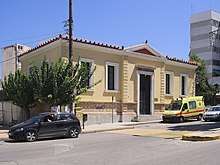
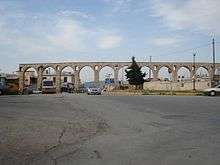
The earliest recorded mention of Chalcis is in the Iliad,[5] where it is mentioned in the same line as its rival Eretria. It is also documented that the ships set for the Trojan War gathered at Aulis, the south bank of the strait nearby the city. Chamber tombs at Trypa and Vromousa dated to the Mycenaean period were excavated by Papavasiliou in 1910. In the 8th and 7th centuries BC, colonists from Chalcis founded thirty townships on the peninsula of Chalcidice and several important cities in Magna Graecia, such as Naxos, Rhegion and Cumae. Its mineral produce, metal-work, purple and pottery not only found markets among these settlements, but were distributed over the Mediterranean in the ships of Corinth and Samos.
With the help of these allies, Chalcis engaged the rival league of its neighbour Eretria in the so-called Lelantine War, by which it acquired the best agricultural district of Euboea and became the chief city of the island. Late in the 6th century BC, its prosperity was broken by a disastrous war with the Athenians, who expelled the ruling aristocracy and settled a cleruchy on the site. Chalcis subsequently became a member of both the Delian Leagues.
Chalkis has had a Greco-Jewish presence since antiquity, which is sometimes claimed to have been continuous and to thus form Europe's oldest Jewish community,[6] although there is no evidence of it through the early Middle Ages.[7]
In the Hellenistic period, it gained importance as a fortress by which the Macedonian rulers controlled central Greece. It was used by kings Antiochus III of Syria (192 BC) and Mithradates VI of Pontus (88 BC) as a base for invading Greece.
Under Roman rule, Chalcis retained a measure of commercial prosperity within the province of Achaea (the southern half of Greece).
Middle Ages and early Modern period
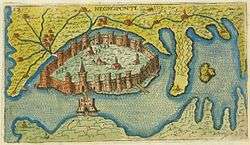
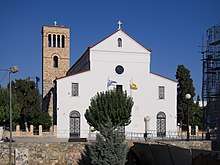
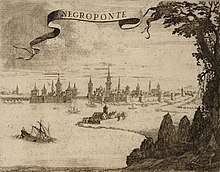
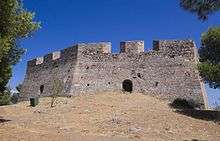
It is recorded as a city in the 6th-century Synecdemus and mentioned by the contemporary historian Procopius of Caesarea, who recorded that a movable bridge linked the two shores of the strait.[8] In Byzantine times, Chalcis was usually called Euripos, a name also applied to the entire island of Euboea, although the ancient name survived in administrative and ecclesiastical usage until the 9th century; alternatively, it is possible that the name was given anew to a settlement that was founded in the 9th century in the location of the ancient city, after the latter had been abandoned in the early Middle Ages.[8] The town survived an Arab naval raid in the 880s and its bishop is attested in the 869–70 Church council held at Constantinople.[8]
By the 12th century, the town featured a Venetian trading station, being attacked by the Venetian fleet in 1171 and eventually seized by Venice in 1209, in the aftermath of the Fourth Crusade.[8]
For Westerners, its common name was Negropont or Negroponte. This name comes indirectly from the Greek name of the Euripus Strait: the phrase στὸν Εὔριπον 'to Evripos', was rebracketed as στὸ Νεὔριπον 'to Nevripos', and became Negroponte in Italian by folk etymology, the ponte 'bridge' being interpreted as the bridge of Chalcis[9] to Boeotia.
The town was a condominium between Venice and the Veronese barons of the rest of Euboea, known as the "triarchs", who resided there. Chalcis or Negroponte became a Latin Church diocese, see below. A large hoard of late medieval jewellery dating from Venetian times was found in Chalcis Castle in the nineteenth century and is now in the British Museum.[10] The synagogue dated to around 1400.[11]
Negroponte played a significant role in the history of Frankish Greece, and was attacked by the Principality of Achaea in the War of the Euboeote Succession (1257/8), the Catalan Company in 1317, the Turks in 1350/1, until it was finally captured by the Ottoman Empire after a long siege in 1470.[8] That siege is the subject of the Rossini opera Maometto II. The Ottomans made it the seat of the Admiral of the Archipelago (the Aegean Islands). In 1688, it was successfully held by the Ottomans against a strong Venetian attack.[12]
The modern town


Chalkida became part of the newborn Greek state after the Greek War of Independence. The modern town received an impetus in its export trade from the establishment of railway connection with Athens and its port Piraeus in 1904. In the early 20th century it was composed of two parts—the old walled town at the bridge over the Euripus, where a number of Turkish families continued to live until the late 19th century, and a sizeable Jewish community lived until World War II, and the more modern suburb that lies outside it, chiefly occupied by Greeks.
The old town, called the Castro (citadel), was surrounded by a full circuit of defense walls until they were completely razed for urban development around the start of the 20th century.[13][14]
The city is served by a railway station and is the terminus for the fast transit system to Athens.
Ecclesiastical history
Greek bishopric
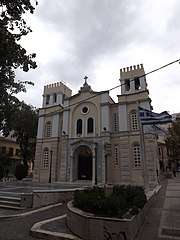
The Byzantine diocese of Chalkis was initially a suffragan of the Archdiocese of Corinth, but in the 9th century was transferred to the Metropolitan of Athens, remaining in the sway of the Patriarchate of Constantinople. It was also known as Euripo, like it's mentioned in the Byzantine imperial Notitia Episcopatuum since emperor Leo VI the Wise (886-912).
Several of its Greek bishops are recorded, but some disputed :
- Constantinus, signed in 458 a letter by the bishops of Greece to Byzantine emperor Leo I the Thracian after the murder by Coptic mobs of patriarch Proterius of Alexandria.
- Lequien list before him Anatolius (in 363), but he was probably bishop of Beroea in Syria Prima (now Aleppo).
- next Lequien inserts, by benefit of doubt, Iohannes Damasceno, whom he also lists as bishop of Euroea (in Phoenicia) alias Evaria, in Phoenicia.
- Teodorus and Teofilattus, successive (?) bishops of Euripus, participated in the 869–70 Church council held at Constantinople.[8] viz. the Council of Constantinople of 879–880, both treating the fate of Patriarch Photios I of Constantinople.
Latin crusader bishopric
At the establishment of the crusader state Lordship of Negroponte, Chalcis or Negroponte (seat of the central one of its three 'triarchies') constituent baronies) became a Latin Church diocese, the first bishop being Theodorus, the Greek bishop of the see, who entered communion with the see of Rome,[15] installed by papal legate.
On 8 February 1314, the Latin see was united in commendam (as an 'additional benefice') with the Latin Patriarchate of Constantinople, so that the exiled Patriarch, excluded from Constantinople itself since the Byzantine reconquest of the city, could have actual jurisdiction on Greek soil and exercise a direct role as head of the Latin clergy in what remained of Latin Greece.[16]
Titular Latin see
The diocese was nominally restored (18the century?) Titular archbishopric of Chalcis (Latin) / Calcide (Curiate Italian), and as such had the following incumbents, of the then fitting Archiepiscopal (intermediary) rank with an episcopal (lower) exception at the apparent start:
- Titular Bishop: Antonio Albergotti (1755.11.17 – ?) no actual prelature recorded
- (Eastern Catholic?) Boghos Maroushian (1832.08.14 – 1838.04.03) as personal honor; next Archeparch (Archbishop) of Istanbul of the Armenians (Turkey) (1838.04.03 – death 1846.08.02)
- Henri-Victor Altamayer, Dominican Order (O.P.) (1884.04.04 – 1887.11.24), as Latin Coadjutor Archbishop of Baghdad (Iraq) (1884.03.27 – 1887.11.24) and Apostolic Delegate (papal diplomatic envoy) to Mesopotamia, Kurdistan and Lesser Armenia (1884.03.27 – 1902.08.28?); later succeeded as Archbishop of Baghdad (Iraq) (1887.11.24 – 1902.08.28), emeritate as Titular Archbishop of Synnada (1902.08.28 – death 1930.11.13)
- Pietro Facciotti (1897.04.19 – ?resigned ?1891.03.11 ?death 1913.04.20) as emeritate (and 'promotion'); previously Titular Bishop of Abila (1879.02.28 – 1880.02.27) as Auxiliary Bishop of Diocese of Palestrina (Italy) (1879.02.28 – 1880.02.27), Bishop of Ferentino (Italy) (1880.02.27 – 1897.04.19)
- Luís Antônio dos Santos (1890.06.26 – death 1891.03.11) as emeritate; previously Bishop of Ceará (Brazil) (1860.09.28 – 1881.03.13), Metropolitan Archbishop of São Salvador da Bahia (Brazil) (1881.03.13 – 1890.06.26)
- Carlo Pietropaoli (1913.04.29 – death 1922.06.29) as papal diplomat : Apostolic Delegate]] to Venezuela (1913.04.29 – 1915), Apostolic Internuncio to Venezuela (1915 – 1918) and on emeritate; previously Bishop of Trivento (Italy) (1897.03.30 – 1913.04.29)
- Johannes Olaf Fallize (born Luxemburg) (1922.10.09 – 1933.10.23) as emeritate ('promoted'); previously Apostolic Prefect of Norway (Norway) (1887.02.06 – 1892.03.11), Titular Bishop of Elusa (1892.03.11 – 1922.10.09) as only (see promoted) Apostolic Vicar of Norway (Norway) (1892.03.11 – 1913.06.01), (see) restyled first Apostolic Vicar of Norway and Spitzbergen (Norway; now diocese of Oslo) (1913.06.01 – 1922.06.21).
In 1925 it was demoted as Titular bishopric of Chalcis (Latin) / Calcide (Italian) and in December 1933.12 renamed as Titular bishopric of Chalcis in Græcia (Latin) / Calcide di Grecia (Italian) / Chalciden(sis) in Græcia (Latin adjective). It is vacant as such since decades, having had a single incumbent of the now fitting Episcopal (lowest) rank :
- Gallus Steiger, Missionary Benedictines (O.S.B.) (1933.12.11 – death 1966.11.26) as personal honor and (next) emeritate; was last Apostolic Prefect of Lindi (Tanzania) (1922.02.22 – 1927.12.15), (see) restyled only Abbot Ordinary of Territorial Abbey of Lindi (Tanzania) (1927.12.15 – 1931.12.23), (see) restyled first Abbot Ordinary of Territorial Abbey of Peramiho (Tanzania) (1931.12.23 – 1952.12.06).
Main sights
The church of Saint Paraskevi (the patron saint of the island) was the church of the Dominican Priory of Negroponte, one of the first two houses authorized for the Order of Preachers' Province of Greece in 1249. Started about 1250, this is among the oldest examples of early Dominican architecture surviving, and is one of the only early Dominican churches to retain its original form until the present.[17][18] The central arch over the iconostasis and the ceiling and walls of the south chapel are the best examples of Italian Gothic stone-carving in Greece.[19] Images of the Dominican saints, Dominic and Peter Martyr, stand at the base of the central arch.[20] The north chapel holds the tomb of the founder of the senatorial Lippamano family of Venice. Some of the column capitals are Byzantine.
The bridges
The town is now connected to the mainland Greece by two bridges, the "Sliding Bridge" in the west at the narrowest point of the Euripus Strait and a suspension bridge.
The Euripus Strait which separates the city and the island from the mainland was bridged in 411 BC with a wooden bridge. In the time of Justinian the fixed bridge was replaced with a movable structure. The Turks replaced this once again with a fixed bridge. In 1856, a wooden swing bridge was built; in 1896, an iron swing bridge, and in 1962, the existing "sliding bridge"; the construction works of the 19th century destroyed the most part of the medieval castle built across the bridge. The Euripus Bridge or Chalcis Bridge, a cable-stayed suspension bridge opened in 1993, joins Chalcis to the mainland to the south.
A special tidal phenomenon takes place in the strait, as strong tidal currents reverse direction once every six hours, creating strong currents and maelstroms.[21][22]
Municipality
The municipality Chalcis was formed at the 2011 local government reform by the merger of Chalcis city itself with four former municipalities, which also became municipal units :[23]
The municipality has an area of 424.766 km2, the municipal unit 30.804 km2.[24]
Transportation
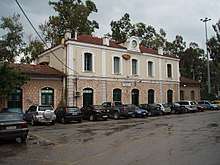
In 2003, a bypass of Chalcis was opened from the southern part of the bridge to connect with GR-77, also with access to GR-44.
Chalcis is also the northern terminus of line 1 of Athens suburban railway (Proastiakos).
Historical population
| Year | Town population | Municipality population |
|---|---|---|
| 1981 | 44,847 | - |
| 1991 | 51,646 | - |
| 2001 | 53,584 | - |
| 2011 | 59,125 | 102,223 |
Notable residents
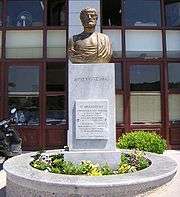
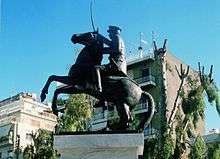
- Aristotle (384–322 BC, ancient philosopher, lived in Chalcis the last year of his life (323–322 BC))
- Giovanni Maria Angiolello from Vicenza, Italy, 15th century.
- Yiannis Anastasopoulos (1931–present), author
- Eva Asderaki Professional Tennis Umpire, first woman to umpire the US Open tennis final. [25]
- Sotiria Bellou (1921–1997), singer
- Angelos Basinas (1976–present), professional footballer
- Nikolaos Christodoulou, military officer
- Mordehai Frizis (1893–1940), military officer
- Dimitrios Katheniotis, military officer
- Nikolaos Kalogeropoulos, PM of Greece
- Konstantinos Kallias (1901–2004), politician
- Orestis Makris (1898–1975), actor and tenor
- Dimitris Mytaras (1934–2017), painter
- Georgios Papanikolaou (1883–1962), physician, Pap smear test founder
- Nikos Skalkottas (1901–1949), composer
- Giannis Skarimpas (Agia Efthymia, 1893–1984), author
Sports teams
Chalcis also has a water polo team named NC Chalkida, a football (soccer) team named Chalkida F.C., as well as a junior football team named Evoikos Chalkida.
The Chalkida football team merged with Lilas Vasilikou for a period of two years (2004–2006). The team was finally dissolved because of financial difficulties. Although there was a team created with the same name (AOX) it does not represent the glorious team of the past.
Chalcis also has a basketball team (AGEX), which previously played in the Greek A2 Basketball League. For a while, Chalkida hosts the basketball team Ikaros Chalkidas that played in the top Greek Basket League.
| Sport clubs based in Chalkida | |||
|---|---|---|---|
| Club | Founded | Sports | Achievements |
| NO Chalkida | 1933 | Water Polo | Earlier presence in A1 Ethniki |
| Chalkida F.C. | 1967 | Football | Earlier presence in A Ethniki |
| AGE Chalkida BC | 1976 | Basketball | Earlier presence in A2 Ethniki |
Geography
Climate
Chalcis has a mediterranean climate (Köppen climate classification: Csa), closely bordering a semi-arid climate with hot, dry summers and mild, rainy winters.
| Climate data for Chalcis | |||||||||||||
|---|---|---|---|---|---|---|---|---|---|---|---|---|---|
| Month | Jan | Feb | Mar | Apr | May | Jun | Jul | Aug | Sep | Oct | Nov | Dec | Year |
| Average high °C (°F) | 12.9 (55.2) |
13.6 (56.5) |
16.0 (60.8) |
20.3 (68.5) |
25.3 (77.5) |
29.8 (85.6) |
32.6 (90.7) |
32.3 (90.1) |
28.9 (84.0) |
23.1 (73.6) |
18.6 (65.5) |
14.7 (58.5) |
22.3 (72.1) |
| Daily mean °C (°F) | 9.3 (48.7) |
9.8 (49.6) |
11.7 (53.1) |
15.5 (59.9) |
20.2 (68.4) |
24.6 (76.3) |
27.0 (80.6) |
26.6 (79.9) |
23.3 (73.9) |
18.3 (64.9) |
14.4 (57.9) |
11.1 (52.0) |
17.7 (63.9) |
| Average low °C (°F) | 6.5 (43.7) |
6.9 (44.4) |
8.4 (47.1) |
11.6 (52.9) |
15.4 (59.7) |
20.1 (68.2) |
22.5 (72.5) |
22.3 (72.1) |
19.2 (66.6) |
14.9 (58.8) |
11.4 (52.5) |
8.3 (46.9) |
14.0 (57.2) |
| Average rainfall mm (inches) | 44.6 (1.76) |
48.3 (1.90) |
42.6 (1.68) |
28.2 (1.11) |
17.2 (0.68) |
9.7 (0.38) |
4.2 (0.17) |
4.6 (0.18) |
11.9 (0.47) |
47.7 (1.88) |
50.6 (1.99) |
66.6 (2.62) |
376.2 (14.82) |
| Average relative humidity (%) | 72 | 71 | 68 | 62 | 58 | 52 | 48 | 49 | 56 | 66 | 73 | 73 | 62 |
| Mean monthly sunshine hours | 137.9 | 144.5 | 187.5 | 238.9 | 303.3 | 341.2 | 373.7 | 356.5 | 283.4 | 218.5 | 164.3 | 136.4 | 2,886.1 |
| Source 1: www.yr.no [26] | |||||||||||||
| Source 2: www.weather.gr [27] | |||||||||||||
See also
References
- "Απογραφή Πληθυσμού - Κατοικιών 2011. ΜΟΝΙΜΟΣ Πληθυσμός" (in Greek). Hellenic Statistical Authority.
- Oxford English Dictionary, 1st ed. "Chalcidian, n. & adj.3". Oxford University Press (Oxford), 1933.
- Richmond, Henry J. (1905), The Pronunciation of Greek and Latin Proper Names in English, Ann Arbor: George Wahr, p. 32, archived from the original on 2016-03-04
- Simon C. Bakhuizen, R. Kreulen, Chalcis-in-Euboea: Iron and Chalcidians Abroad, Brill Archive, 1976, p. 58.
- Homer, Il., Bk. II, l. 537.
- "ΚΟΙΝΟΤΗΤΑ ΧΑΛΚΙΔΑΣ - ΙΣΤΟΡΙΚΟ". Kis.gr. Retrieved 13 January 2018.
-

- Gregory, Timothy E. (1991). "Chalkis in Greece". In Kazhdan, Alexander (ed.). The Oxford Dictionary of Byzantium. Oxford University Press. p. 407. ISBN 978-0-19-504652-6.
- Edward Gibbon, The Decline and Fall of the Roman Empire, J.B. Bury, ed., Methuen, 1898 p. 6:390, footnote 69
- "Collection search: You searched for". British Museum. Retrieved 13 January 2018.
- JE (1902).
- Kevin Andrews, Castles of the Morea. Gennadeion Monographs 4. Princeton: ASCSA Publications 2006 [1953]. p. 185-6
- Andrews, Castles of the Morea. p. 191.
- Spyros Kokkinis, "Ἱστορικὰ μνημεῖα καὶ λαϊκὴ ἀρχιτεκτονικὴ στὴν Χαλκίδα". Ἀρχεῖον Εὐβοϊκῶν Μελετῶν, 15 (1969), 149—248.
- Michel Lequien, Oriens christianus in quatuor Patriarchatus digestus, Paris 1740, Vol. II, coll. 212-215
- Loenertz, R.-J. (1966). "Cardinale Morosini et Paul Paléologue Tagaris, patriarches, et Antoine Ballester, vicaire du Papae, dans le patriarcat de Constantinople (1332-34 et 1380-87)". Revue des études byzantines (in French). 24: 224–256. doi:10.3406/rebyz.1966.1373.CS1 maint: ref=harv (link)
- Nikolaus Delinikolaos and Vasiliki Vemi, "Αγία Παρασκευή Χαλκίδας. Ένα βενετικό πρόγραμμα ανοικοδόμησης του 13ο αιώνα." in Chryssa Maltezou and Christina E. Papakosta eds., Venezia-Eubea, Da Egripos a Negroponte, 2006, 229-266, at pages 248—49.
- Pierre MacKay, "St. Mary of the Dominicans: The Monastery of the Fratres Praedicatores in Negropont." in Chryssa Maltezou and Papakosta eds., Venezia-Eubea, 125-156.
- Ramsay Traquair, "Frankish Architecture in Greece," Journal of the Royal Institute of British Architects Third Series, 31, (1923—24) 42—48, fig. 13 ("Italian Gothic", p. 47).
- The two first Dominican saints can just be made out at the base of the arch in a photograph in Beata Panagopoulos, Cistercian and Mendicant Monasteries in Mediaeval Greece. Chicago, 1979, plate 105, p. 133, but not with any detail.
- Eginitis, D. (1929). "The problem of the tide of Euripus". Astronomische Nachrichten. 236 (19–20): 321–328. Bibcode:1929AN....236..321E. doi:10.1002/asna.19292361904. See also the commentary about this explanation in Lagrange, E. (1930). "Les marées de l'Euripe". Ciel et Terre (Bulletin of the Société Belge d'Astronomie) (in French). 46: 66–69. Bibcode:1930C&T....46...66L.
- "Evia Island". Chalkis. Evia.gr. Retrieved 29 June 2013.
- "Kallikratis law" (PDF) (in Greek). Greece Ministry of Interior. Retrieved 13 January 2018.
- "Population & housing census 2001 (incl. area and average elevation)" (PDF) (in Greek). National Statistical Service of Greece. Archived from the original (PDF) on 2015-09-21.
- "The View from the Umpire Chair: Not Always the Best Seat in the House". FryingPanSports.
- "Weather statistics for Chalcis, Central Greece (Greece)". Yr.no. Retrieved 23 March 2015.
- "ATHENS (NAT.OBS.) Climate". Weather.gr. Retrieved 13 January 2018.
Sources and external links
| Wikimedia Commons has media related to Municipality of Chalkida. |

- , Encyclopædia Britannica, 5 (11th ed.), 1911, p. 804
- GCatholic - (former and titular) Latin see
- Photos from Chalcis, Evoia
- Herodotus Project: B+W photo essay of ancient Chalcis
- Bibliography - ecclesiastical history
- Pius Bonifacius Gams, Series episcoporum Ecclesiae Catholicae, Leipzig 1931, pp. 430–431
- Michel Lequien, Oriens christianus in quatuor Patriarchatus digestus, Paris 1740, Vol. II, coll. 212-215
- Gaetano Moroni, Dizionario di erudizione storico-ecclesiastica, vol. 47, pp. 262–263
- Konrad Eubel, Hierarchia Catholica Medii Aevi, vol. 1, p. 367; vol. 2, p. 203; vol. 3, p. 259
- Raymond Janin, v. 2. 'Chalcis', in Dictionnaire d'Histoire et de Géographie ecclésiastiques, vol. XII, Paris 1953, coll. 278-279

